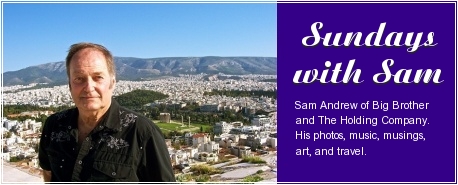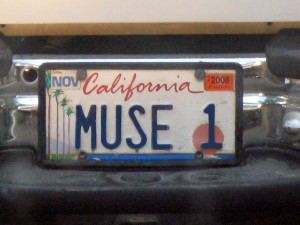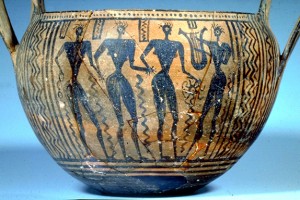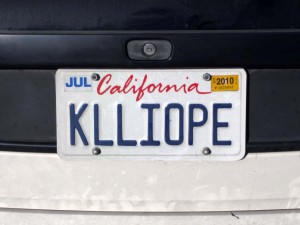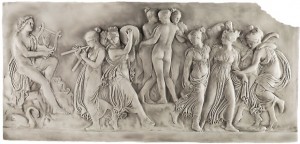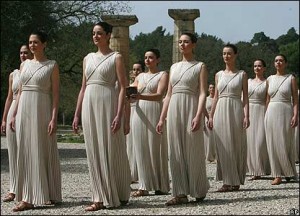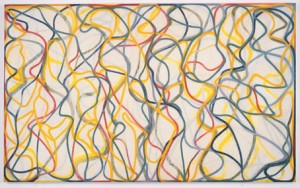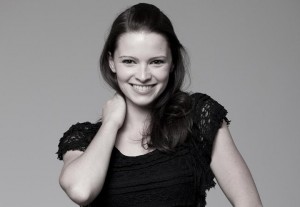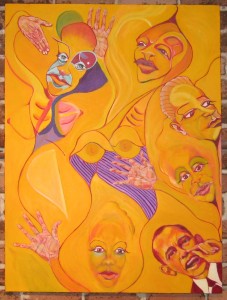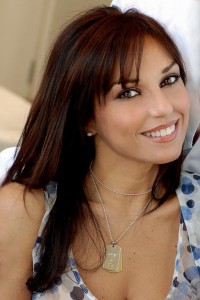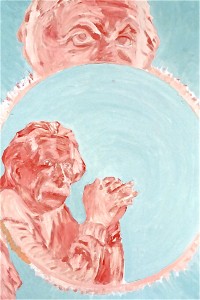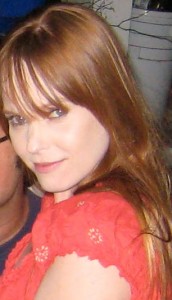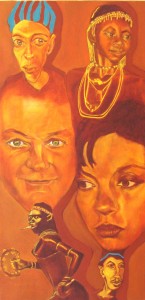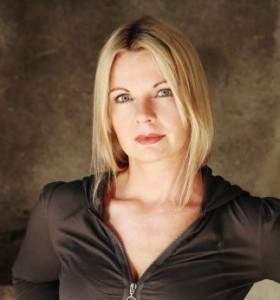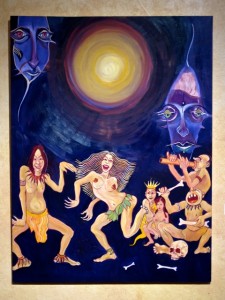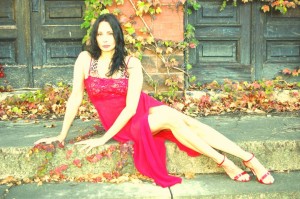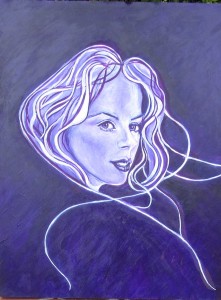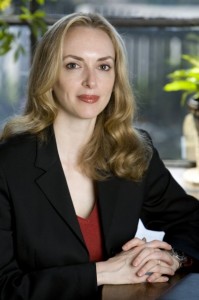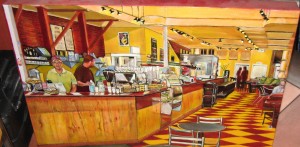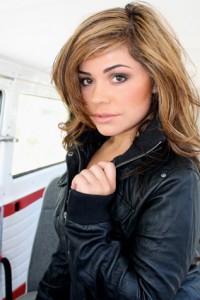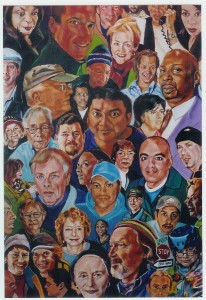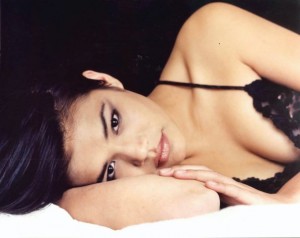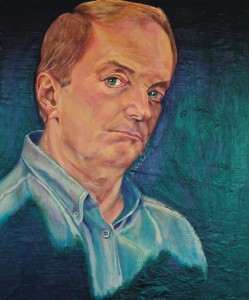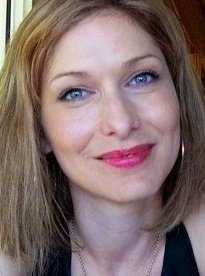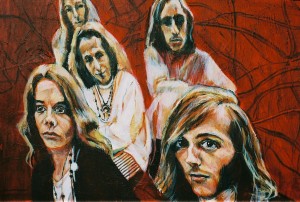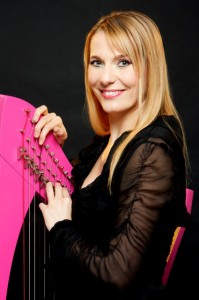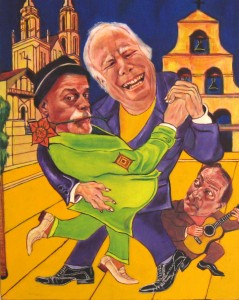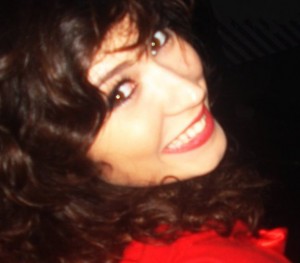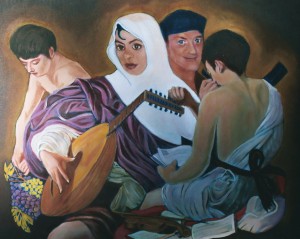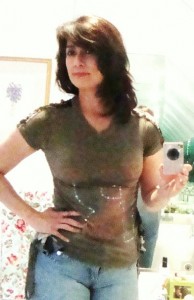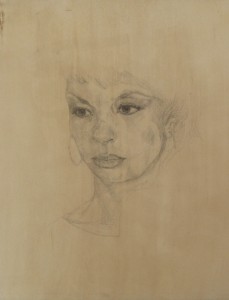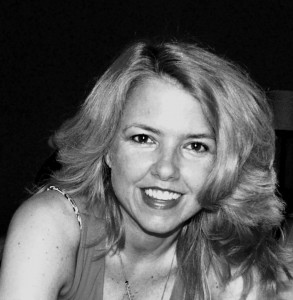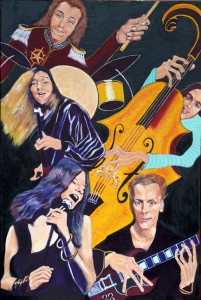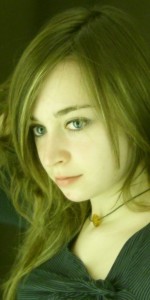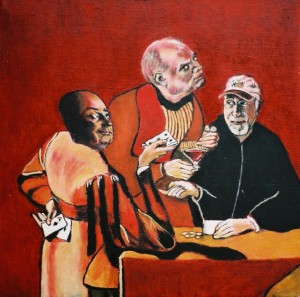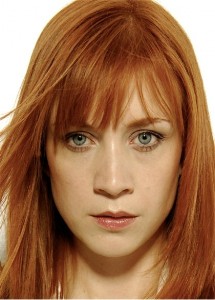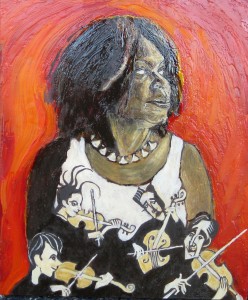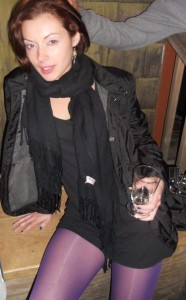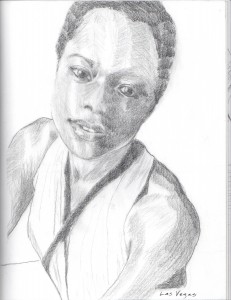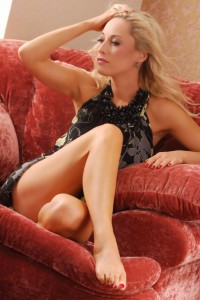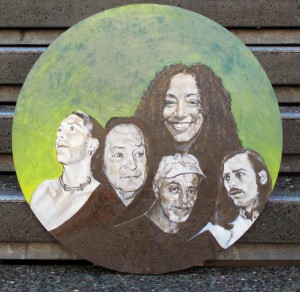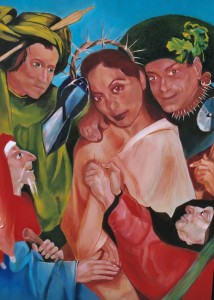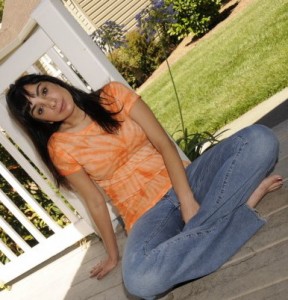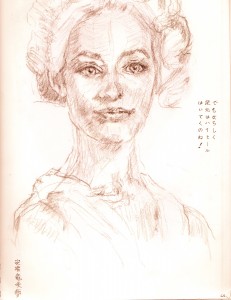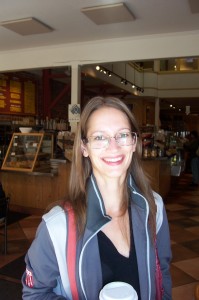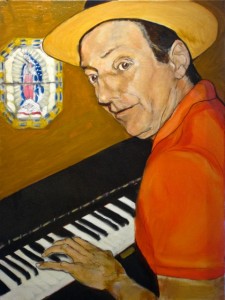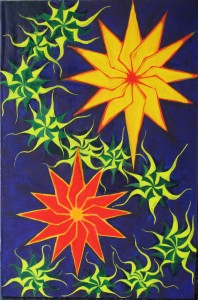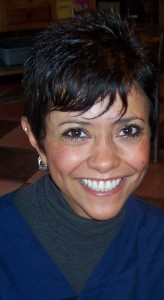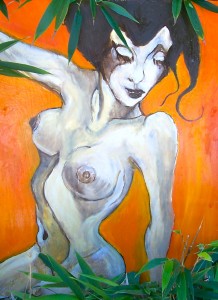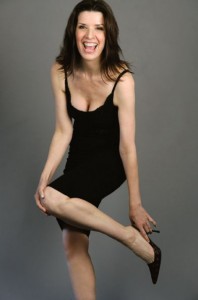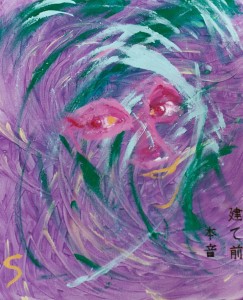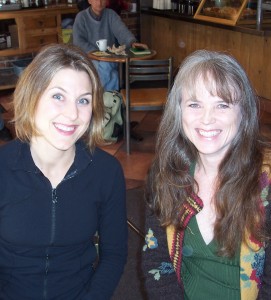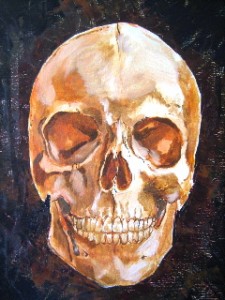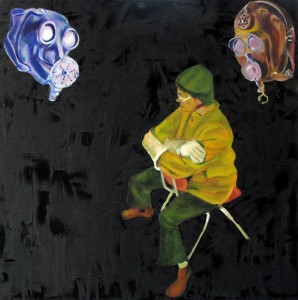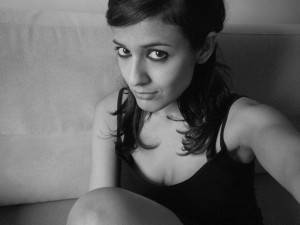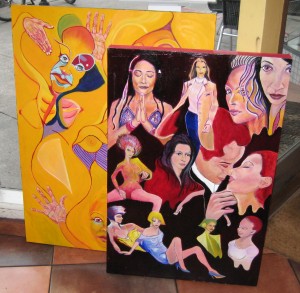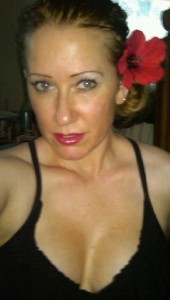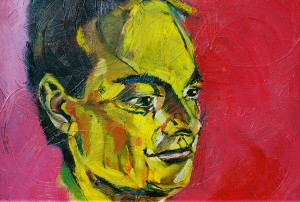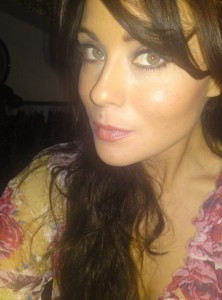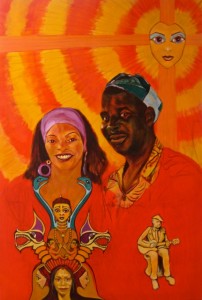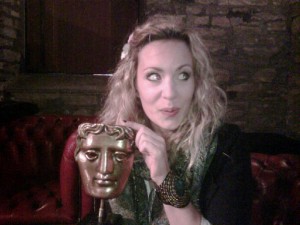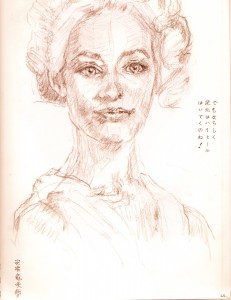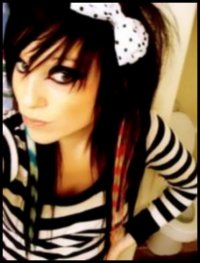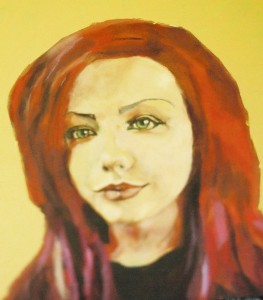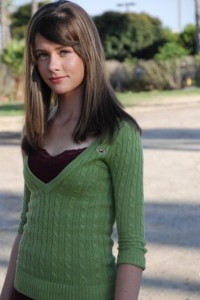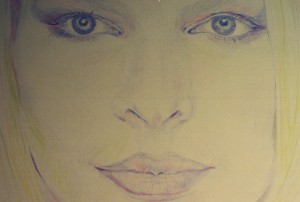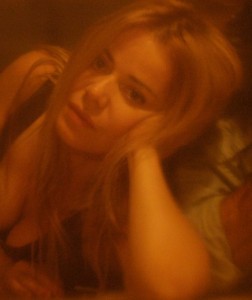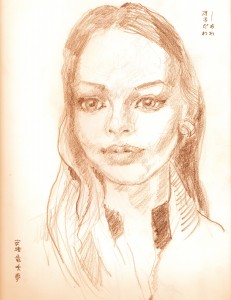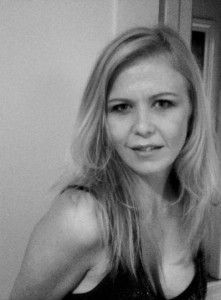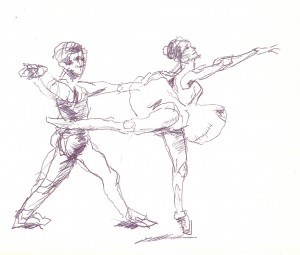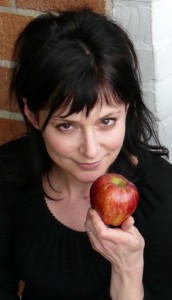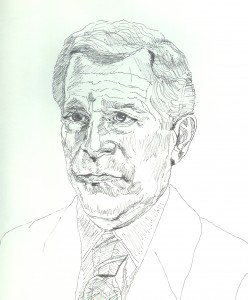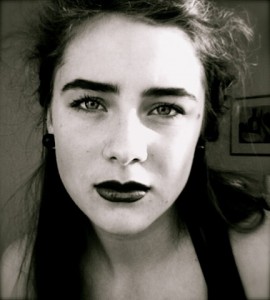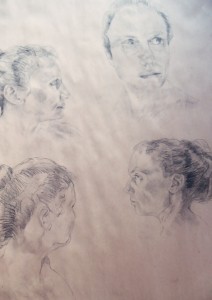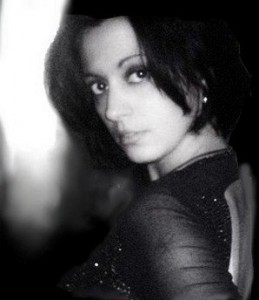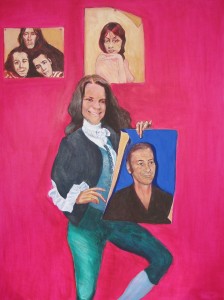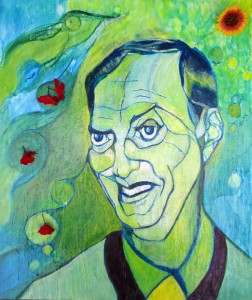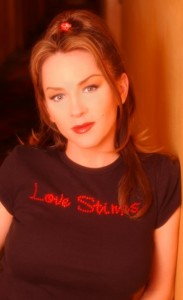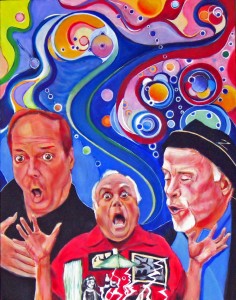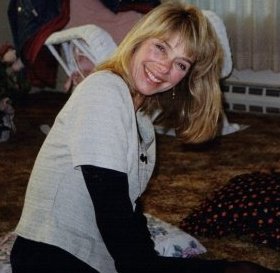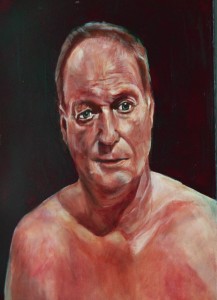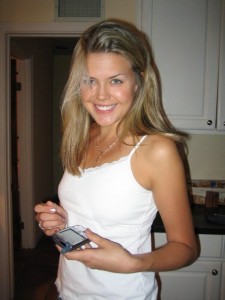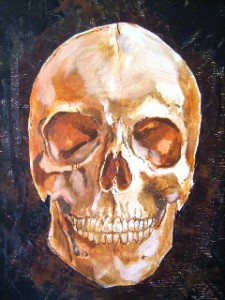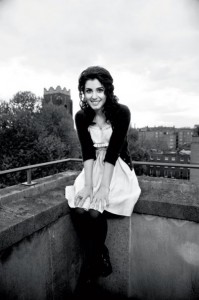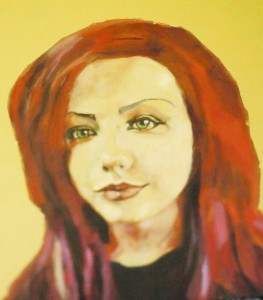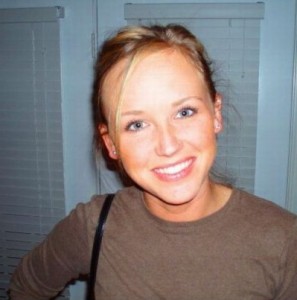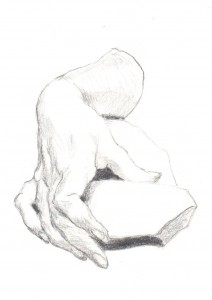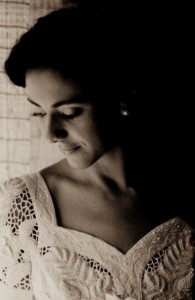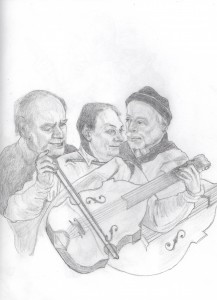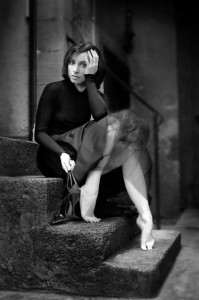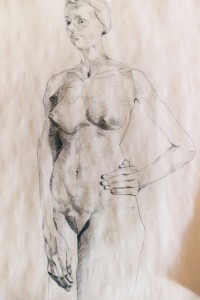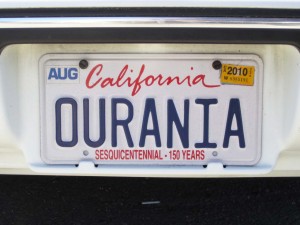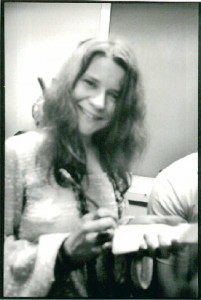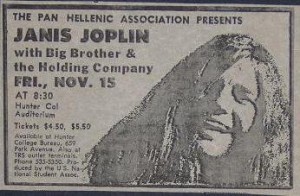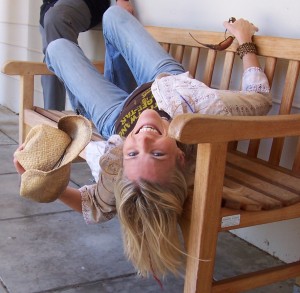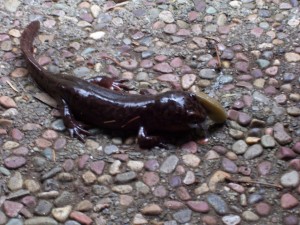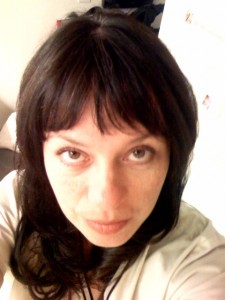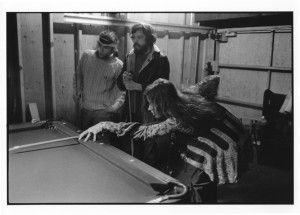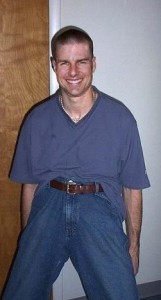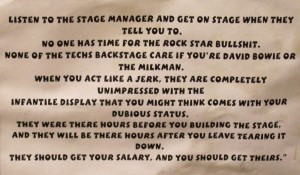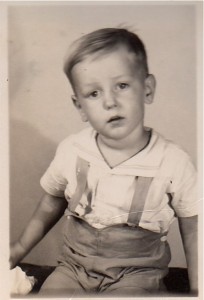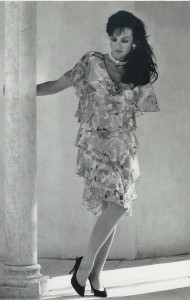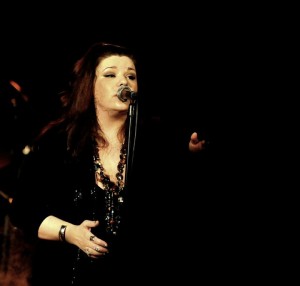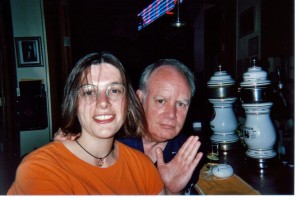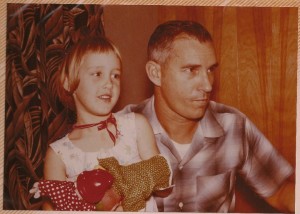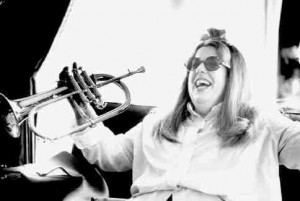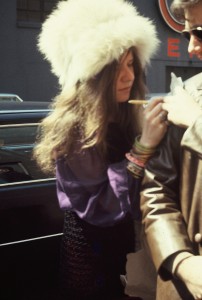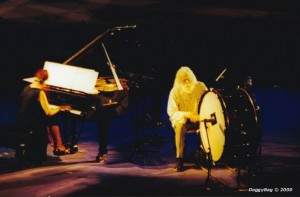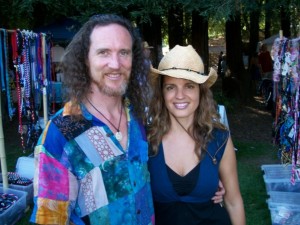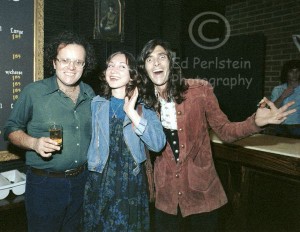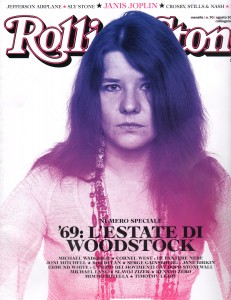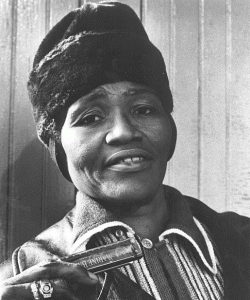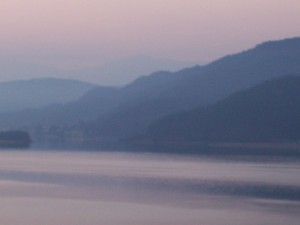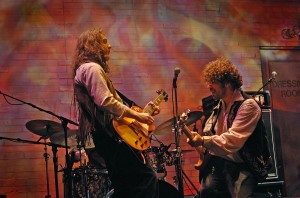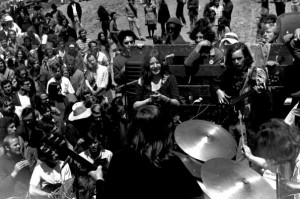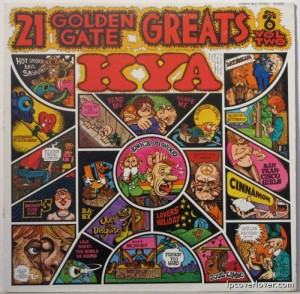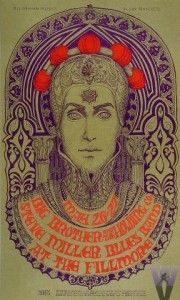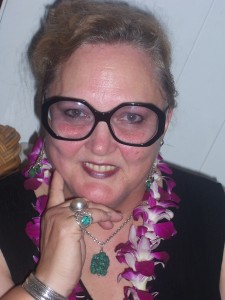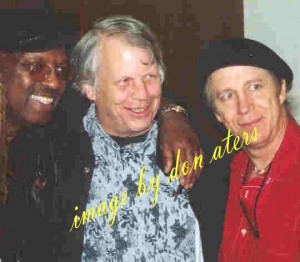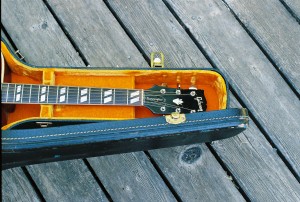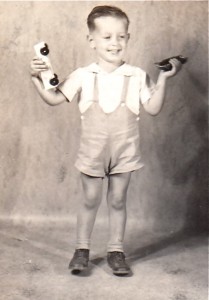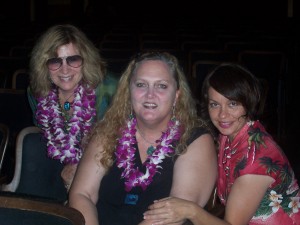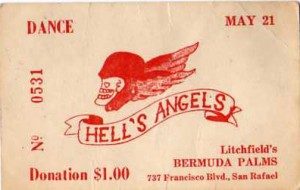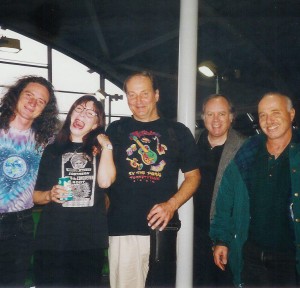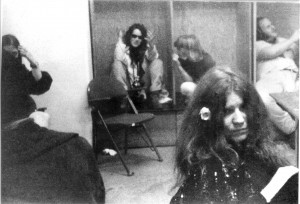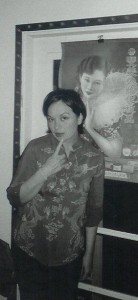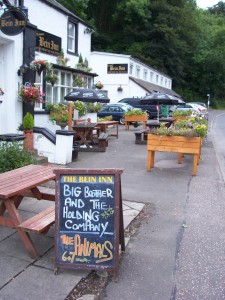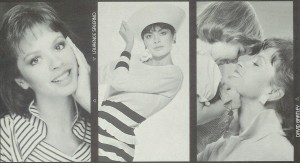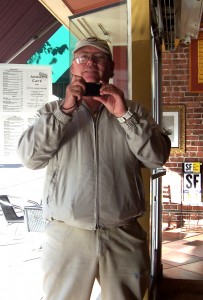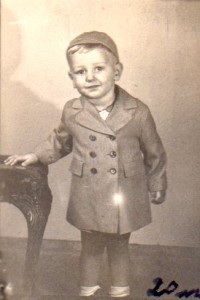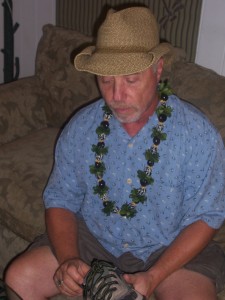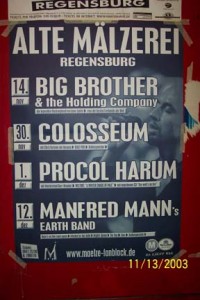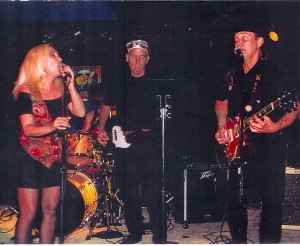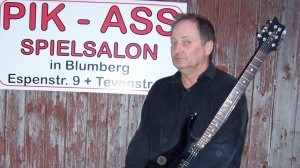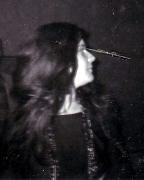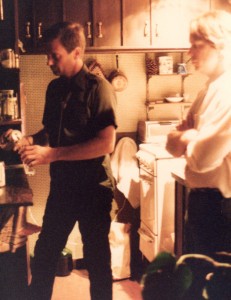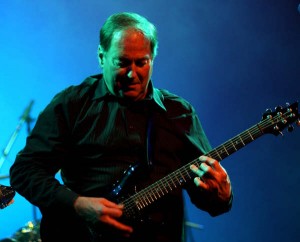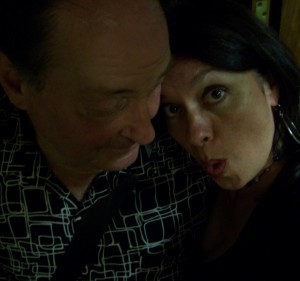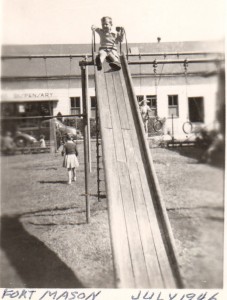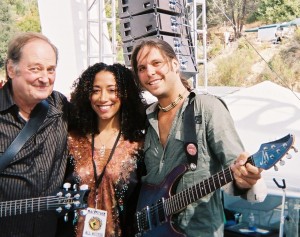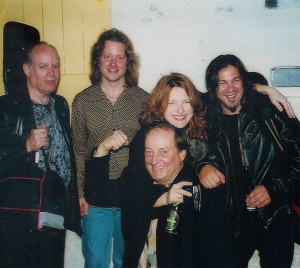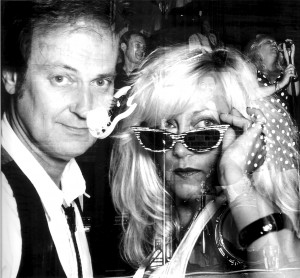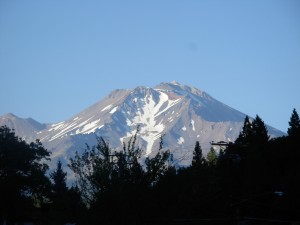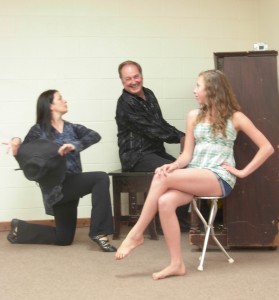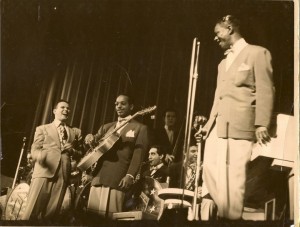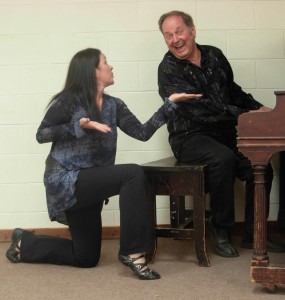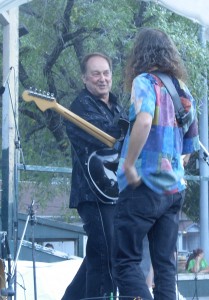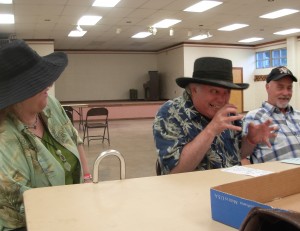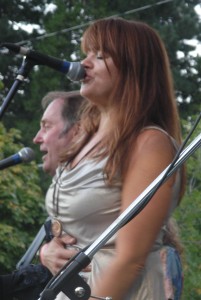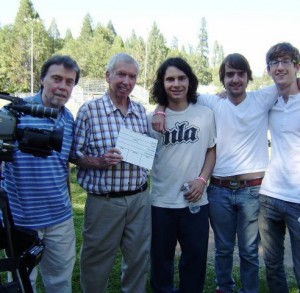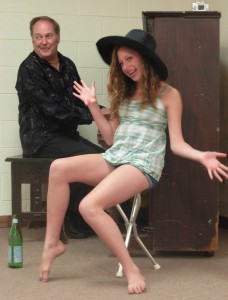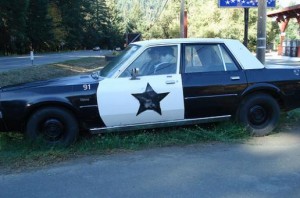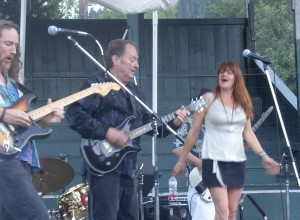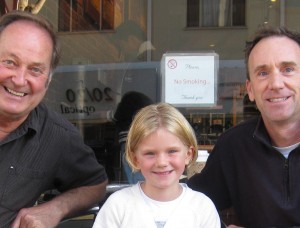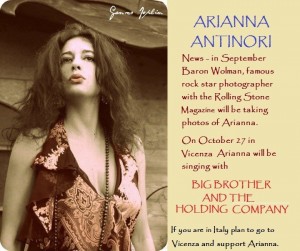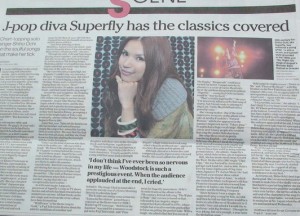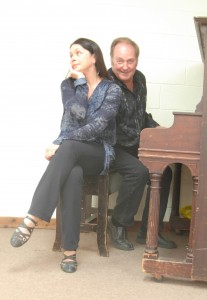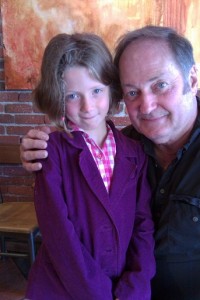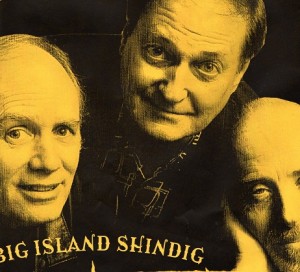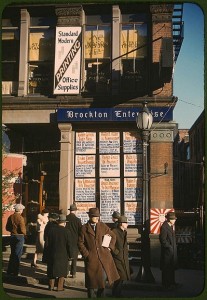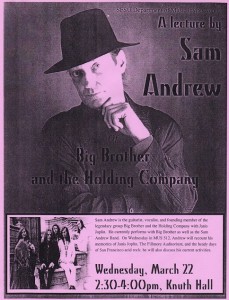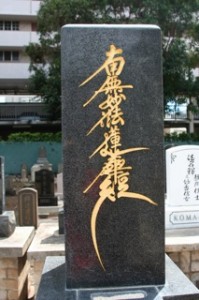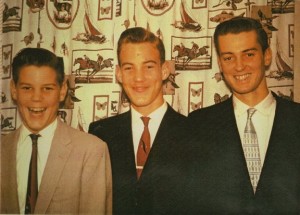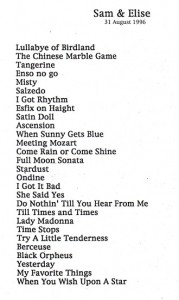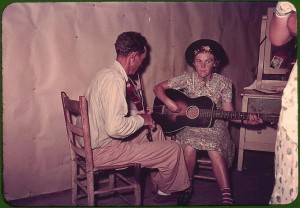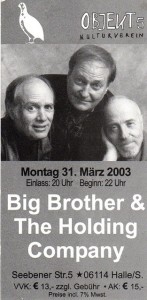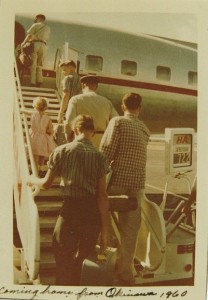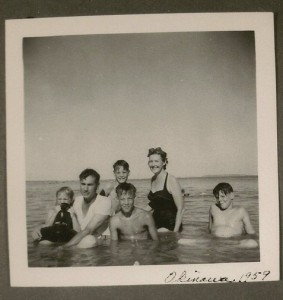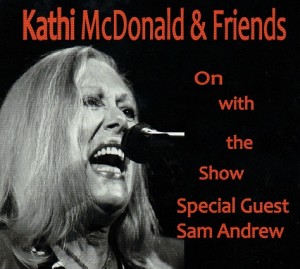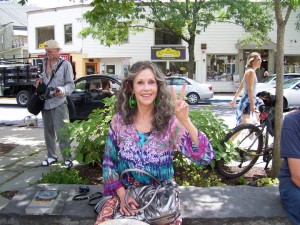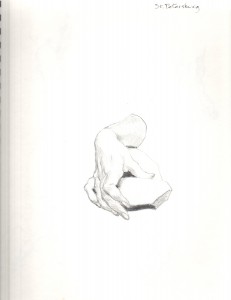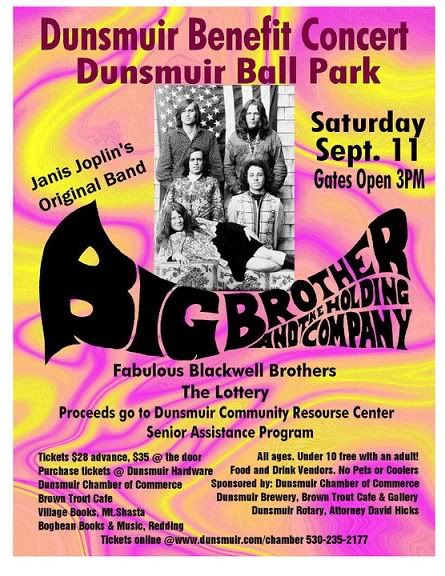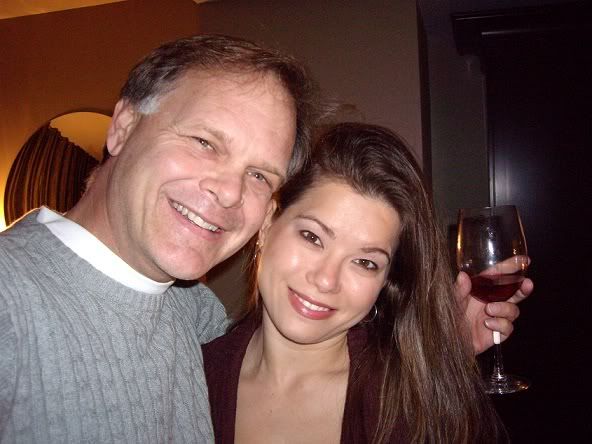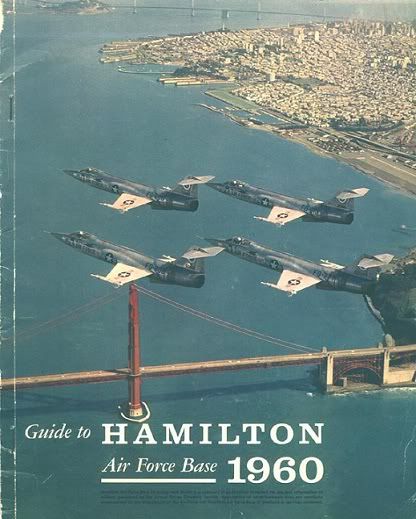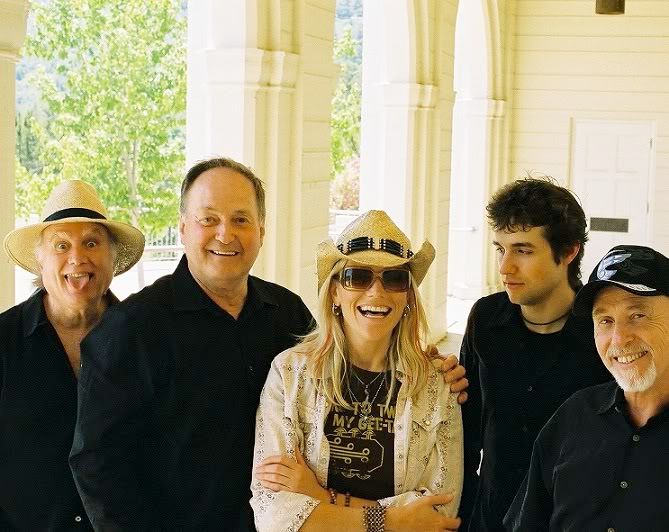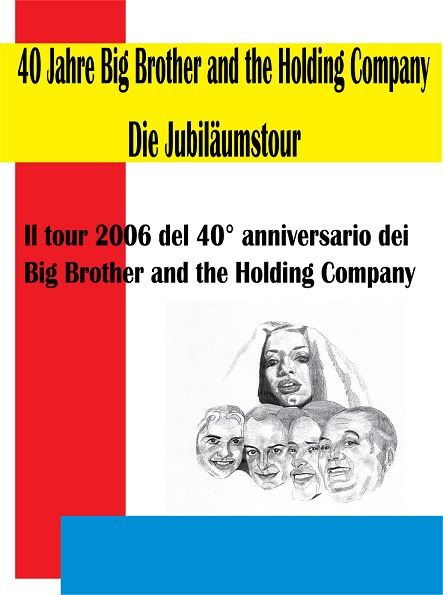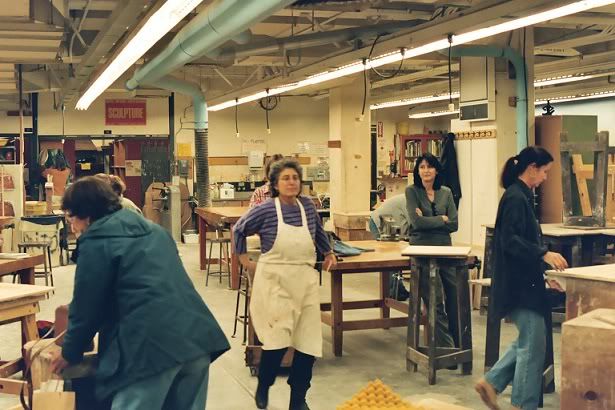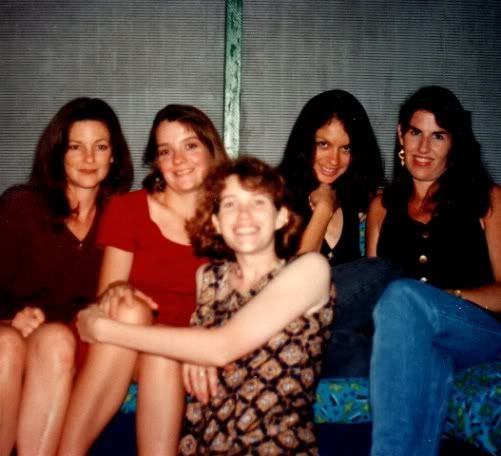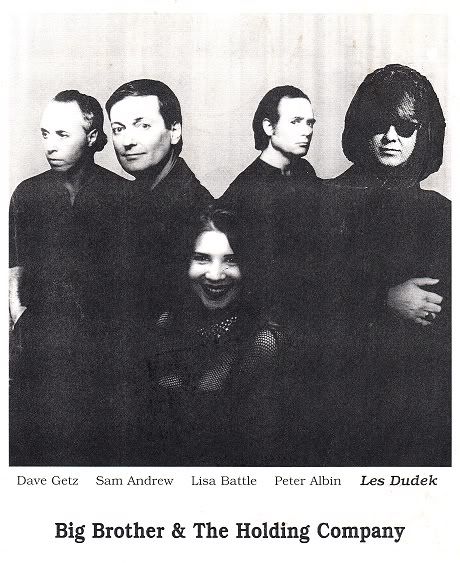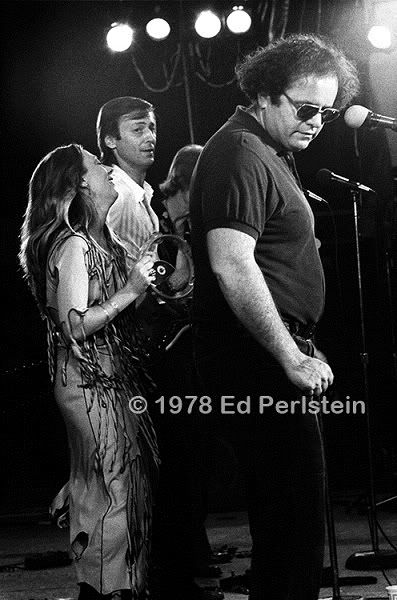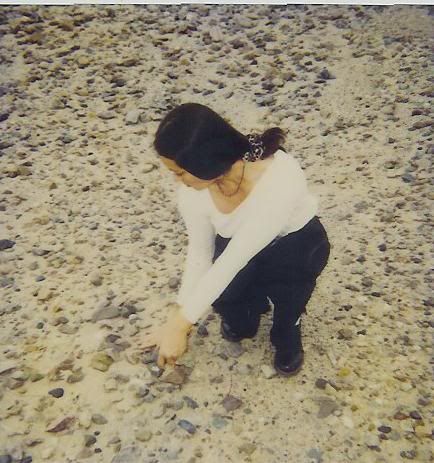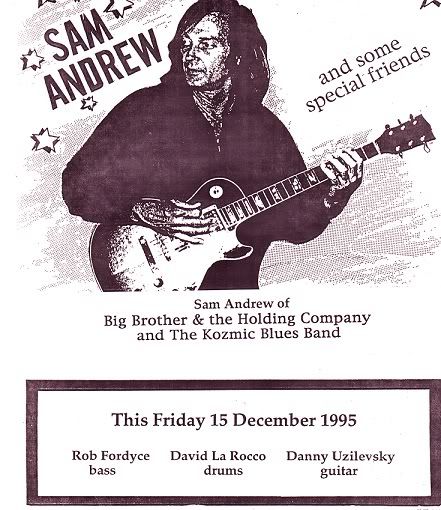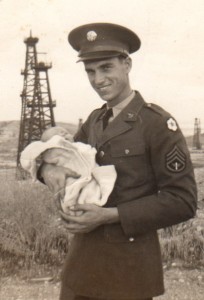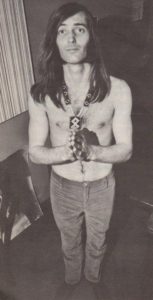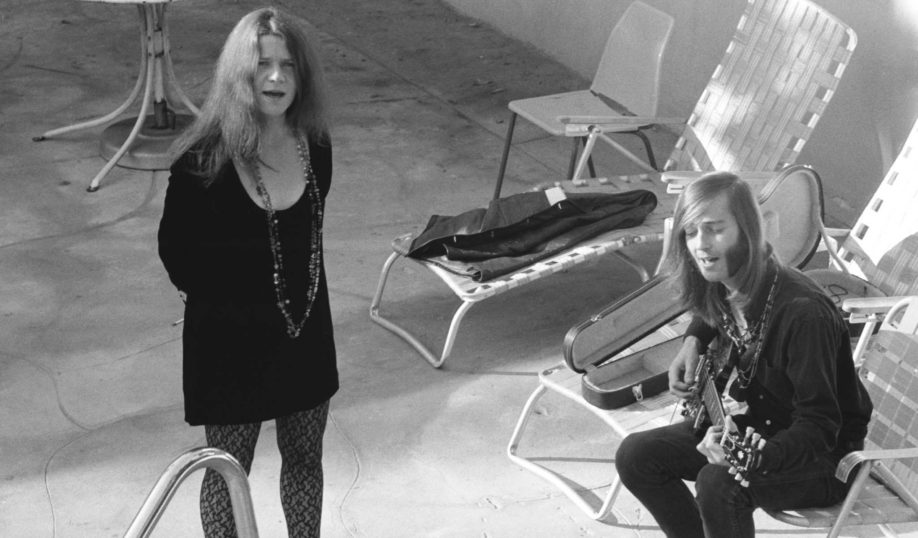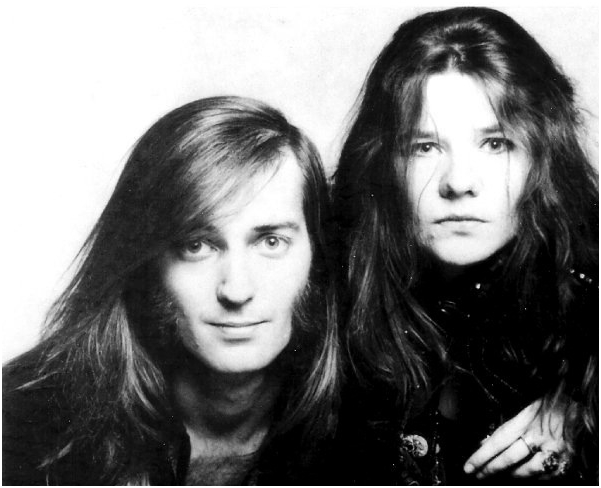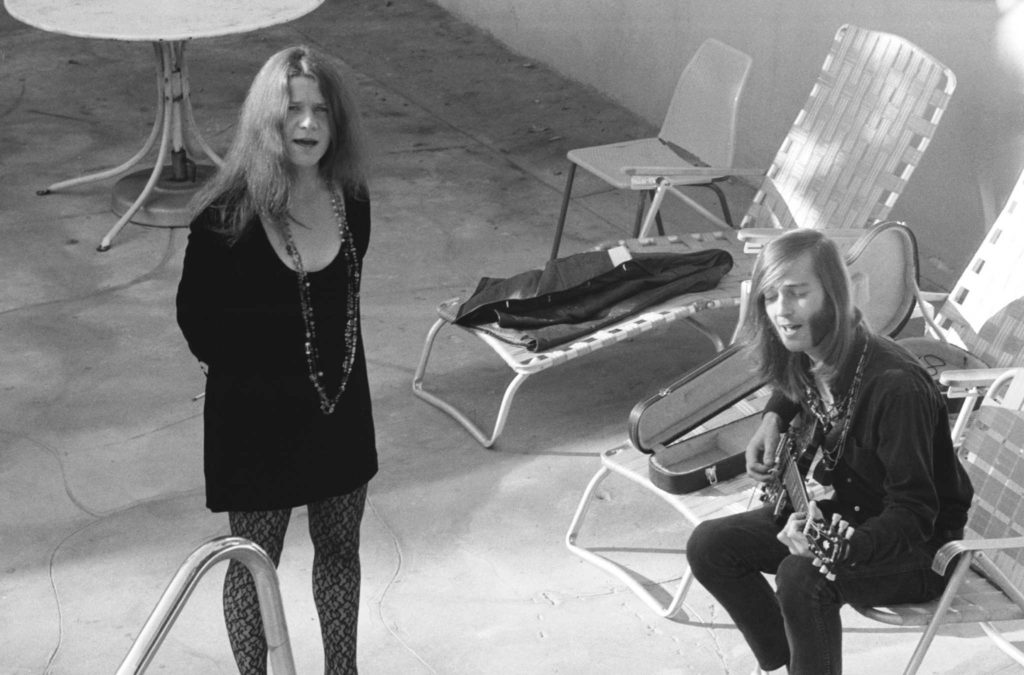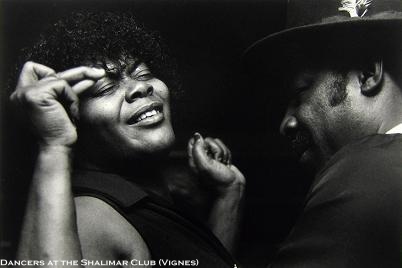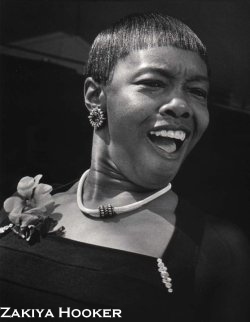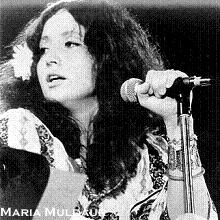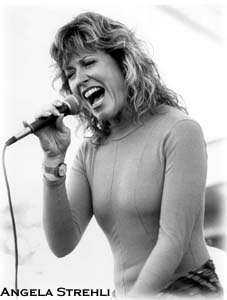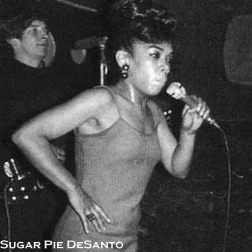I was able to catch up with Sam Andrew at his home in San Rafael, California. It was a hot July day when we sat down and talked. And talked we did. I should have called this a conversation with Sam. Yes I had done all my homework. I had read all the books, interviews, articles that I could find on Big Brother and the Holding Company. Sam had even photo copied some he had saved.
Some of my Internet connections even e-mailed me with questions to ask Sam. Nothing I had done prepared me for the interview, which follows. The reason is that once Sam and I started to talk, it was as though two old friends had gotten together. We needed to catch up with what has been happening. Sam is a gracious host and man with a great memory. I am glad that we covered as much ground as we did.
We went beyond Sam’s Big Brother days with Janis, on into his solo years, only to return to Big Brother that we know them today. Make no mistake about the fact that Big Brother is back. With on going concert tours and a new CD, which just came out, titled “Do What You Love”, Sam is more active then ever.
I’d like to thank Sam Andrew, Chuck Flood, Ed Chester, Todd Bolton and the man who transcribed this interview Bill Delaney.
John Barthel
J. I was just wondering, as a first question, if we could go way back to when you were a teenager. I don’t know if you went to high school but when you were a teenager in your formative years, what kind of music did you enjoy?
S. Well I went to high school on Okinawa. It is now a part of Japan. It is one of the prefects of Japan but then it was a part of America. It is… was like a territory. We got it from World War II. My father was stationed there twice. I went to kindergarten there and I graduated from high school there and that’s were I had my first rock and roll band called the Cool Notes. In that band I was lucky enough to have two horn players who had come down from Tokyo with their fathers. One was fourteen and the other was sixteen. The fourteen-year-old was a prodigy. He was something approaching a musical genius. Now he plays in the studios in London. He does like alto sax work for everybody; you know David Bowie and everybody who comes through. They were big influences on me, they listened to a lot of classical music and that kind of thing. I had been listening to a lot of black music. Little Richard was a big, big influence on me and Chuck Berry and Bo Diddely. It was kind of guitar oriented, although Richard plays the piano. I was really into that because I had been living in the South for most of my childhood and had just come from, in fact, San Antonio, Texas. Where all of the Mexicans and low class whites, like I was, would listen to southern black blues music. There were a lot of big radio stations that came out of Nashville. Which you must know about. Joe Rio.
J. Right
S. So I was really in that black thing and when these horn players came down they exposed me to a whole…. Like to Benny Goodman all of the big band tradition because they were horn players. We wrote a lot of songs, which at that time was very unusual. This is the late fifties. This is like 1957. We had a band and we played at teen clubs and we made a lot of money. We had a weekly television program on Okinawa. So those would be the two things. It would be like southern black blues, a real strong thing, and then these horn players, coming from Chicago and exposing me to all that.
J. So you were playing to Military teenagers and young adults?
S. Yeah, to offspring of military personnel and military personnel themselves. We would have that weekly show that was like American Bandstand only it was on Okinawa. On that island everybody was military so all of the grown up jobs couldn’t be done by grownups because they were all in the service. So all of those jobs fell on us including our band doing that weekly television program. I had friends who were like disc jockeys on the radio and editorial cartoonists and that kind of thing. It was a fun spot to be at sixteen.
J. So how did you get off Okinawa?
S. My father got transferred back here. We’re in San Rafael California. He was transferred to Hamilton Air Force Base, which is just a little north of here. That is why I am sitting here today because he came here and I went to the University of San Francisco, which was right on the edge of the Haight. So that is why I was here really, because he transferred off the island.
J. You were about the right age to break away from your folks?
S. Yeah! That was my first year of college when I came back. So yeah.
J. You mentioned you were playing with the Cool Notes? S. Yeah.
J. Did you start off playing the guitar?
S. I started off playing guitar. I played piano and saxophone and wrote music but mainly I am guitar player and I played guitar in that band. In those days, that was the late fifties, you may remember this John. You could get away with playing two sets of chords. One set was the blues chords. You could play a lot of songs, mostly anything fast could be played with that set of chords, and that is three chords. Then there was another four set of chords and that was: C, A minor,
F and G7 and those chords you use for a ballad. Any slow ballad like: “You Send Me.” or “Maybe” any of the Doo Woop tunes. Those two sets of chord changes you could play a lot. See I learned how to play in about three months then I was in a band, you know, playing all the time.
J. Pretty much self-taught?
S. Yeah, entirely I have never had a guitar lesson. I have given a lot of guitar lessons, but I have never had one and I wish I would have. Usually when people say things like that you think they are taking pride in being this untutored thing but if I would have had guitar lessons I would be way better. I would encourage anyone thinking of learning guitar to look for Omaha Guitar Lessons so they can learn the basics and build from there. I wish I would have started out. I mean, the first violinist of the Cleveland Symphony still takes lessons probably once a week from somewhere. They know…classical musicians know you should be educated.
J. I was going to ask what are your earliest recollections of writing songs, but you pretty much have said that.
S. Well… Yeah! Except that I wrote them from when I was six years old. I would play a broom and all kids do this. My daughter did it. Any young child will make up songs at the drop of a hat with a melody and everything. All the words come out and it makes sense. But they forget that kind of. You have to keep doing that or you forget it. Just like drawing. All children are fascinated by drawing, you know. They all draw. And they draw the most incredible things and they forget how to do it because they don’t keep doing it. So the first tune that I wrote was called “Sweet and Innocent” and it was to a girlfriend I had at the time on Okinawa. It had those chords: C, A minor, F and G7 and it was like a slow romantic thing. That was it. We wrote a lot of tunes in that band, unusual for that time.
J. When you first started going to college and hanging out next to Haight. What was the Haight like? Everybody hears about Haight Ashberry and the early … what?. You’re talking sixty-four maybe?
S. No, I am talking sixty now.
J. Sixty OK. What did you find there? S. In 1960 I lived at 251 Ashbury. It was just on the other side of the park, but it was still. I was living on Ashbury in 1960. It was real quiet. It was a student neighborhood. It was kind of, perhaps, a blue-collar neighborhood. Just real quiet… one of the many neighborhoods
of San Francisco. There was nothing special about it. I think probably…it actually became something because rents were low and also University of San Francisco was there. Lone Mountain, which was a girls school was there and then San Francisco State was kind of,…on the other side of it. So maybe a lot of students were in the neighborhood, but mainly it was just low rents. J. Yeah, I read that it was low income or low rent like you said.
S. Yeah, It wasn’t poor and it wasn’t even shabby or anything. It was just kind of a respectable quiet neighborhood. It was nice. Still is. Still great. I really love the Haight.
J. So how did you get plugged into the music scene in San Francisco?
S. Well! In school I led the pep band which is pretty ridiculous because there is no music at USF. It is a Jesuit men’s school.. That was to a keep a hand in , on that kind of music with horns and that. I led that band. That was the age of folk music… you know? The Kingston Trio had popularized folk music with the Weavers. Everybody was doing it… Odetta. Joan Baez. It was a big deal. Pete Seger, Bob Dylan, he was still very much folk. He hadn’t started really writing yet. We were doing that. We would gather in student apartments and play the stuff all night, then go out and sleep off the red wine in Golden Gate Park. It was a really nice existence. We would have a lot of fun playing and singing all night and you know we just lived these songs. It was really fun. It was in some ways a more intense musical experience than it is today. It went on…that folk thing… went on until 1963…64 or something. Then I went to Paris where I lived a couple of years and played there a little bit and came back just in time for that explosion that happened at that time.
J. What took you to Paris?
S. My father was over there. He was a little outside of Paris, but my brother went over there and lived right in Paris. We went to the Sourbonne and spoke French to each other. Which is unusual for a couple of Americans and we had that great Parisian….you know, I was like 18 or 19. It is paradise to be in Paris when you are 18 or 19. You know? Had a lot of good times. Visited all the museums of course. I had a lot of friends who were French. Who were painters and that kind of thing. I really enjoyed… I felt very bohemian and with it. I came back and I don’t know why. I thought I was going to stay in Paris forever. I had become really frenchified. I had the identity card and the whole thing. I just thought I was going to stay. I don’t know why I came back but I did. Just in time for this.
J. That brings us to probably when you started hanging out, I forget the address….1090?
S. 1090 Page. Yeah! That was shortly after that….that I came back. Yeah! Maybe within a year. I was walking down the street, on a day very much like today. Which is very sunny and blue and I heard some guitar playing coming out of a window of this Victorian. It was really good. It was really, you know, this really
loose natural blues style. I went up there and it was Peter Albin. I had to climb up there… all those stairs… all the way. There were no doors that were locked in those days to any of those houses. You know? I went all the way up until I found him. I just thought he was so great and I talked to him for a while and he was….he wanted to write children’s songs. He had written a couple. Which we later did in Big Brother by the way, like Caterpillar. He wanted to write those and travel all across the nation and sing those to children and that kind of thing. He was taking care of people at Camp Meeker. I said, “We ought to form a band. I play”. He was kind of…Naa! At first. I had to work on him…a couple of months. I would go over there all the time. We would play down in the basement.
Slowly a band started to coalesce around that. That is where the Blue Yard Hill thing started. That was one of it’s early names, it was called the Blue Yard Hill.
S. It wasn’t my idea.
J. I had read that you had quite a group of people coming in and out. Jamming or playing there.
S. Yeah!
J. I also read that Chet Helms somehow got involved in that mix.
S. He got involved. He visited all of those Victorians in town. Everybody was kind of associated with one of those houses. Like there was some on Pine Street, where Bill Hamm and the first light show that ever was in the world… was. James Gurley was over there at one of those houses on Pine Street. The Family Dog started up. But Chet visited all of these. He was like a bee going around gathering this pollen, you know, and spreading the word… kind of. Yes, 1090 Page was one of those places he visited. He had the idea of charging admission , for when we would jam down there. We had all kinds of people. We had black people from the neighborhood. These really slick guys with the hat and the matching suit. All the way down to what would be called the hippie now and wasn’t called that then and folkies. It was a real mix of people. It wasn’t one kind of person. They would come….seems like it was every Wednesday night, but I can’t be sure of that, but Chet would charge money. Peter and I were kind of the nucleus of the stage band. Gary Duncan came by with John Cippolina and we just thought they were so cool. They already looked…. You know John Cippolina had that rock and roll star thing down from day one. He just looked the part. They came over so we were kind of like, “Ohhhhhh! those guys are serious”. We played Suzy Q with them. I remember that…real early.
J. Were you plugged in at that time when you were jamming?
S. Uh, yeah, we were plugged in, yeah. I don’t think Peter and I ever played acoustic. I think from day one we plugged in when we were down in that basement. I think so. I mean I would bring my acoustic over and play with other people in that house. I came over and played classical music with a guy who was down on the first floor. He played recorder and we did a lot of Bach and eighteenth-century music. I played jazz with some of the people on the upper floor, but Peter and I were electric from day one. He didn’t play bass for a long time. He played guitar.
J. And you had drums?
S. Yeah, eventually we got drums after thinking about the logistics like the best drum kit wrap to put on top. In fact, we got our first drummer there too, Chuck Jones. That was quite a scene down there, but quieter than you would think.
J. How long did that go on? In the basement?
S. That is a good question. Maybe like… about a year , or something,. Because James came to that basement, you know, the guitar player we finally got… came. Chet brought him down to that basement where we were. That is where we had the first full blown Big Brother rehearsal… I guess.
J. I had read that James had taught himself the guitar. He was really into John Coltrane. If you take that and your interest in black music, what kind of music did you play? Did you cover other peoples songs or do originals?
S. Yeah, we did covers. We did a couple of Little Richard covers that I sang. Peter sang Summertime which is ridiculous to think of him singing it. We had that song when Janis came to the band. She didn’t say, “I want to do Summertime”. We were already doing Summertime. It was probably because it was a song we could do. We did, That’s How Strong My Love Is, by Otis Redding. We did it because the Stones did it. We said, “Wow, Mick Jagger really can sing.” I mean… because that is a hard song to sing. When you try to sing it… you go… “wow it is really hard” ! He could sing. He could sing better than we thought he could sing. Just like that. We did a couple of folk tunes. We did… I Know You Rider, which the Dead wound up doing allot, but we didn’t do it because the Dead were doing it. We did it for the same reason they did it, because it was a folk song left over… that we all liked. Peter did… Blind Man , which is an old gospel thing. We did a couple of his children songs. I started writing songs right away. We built up a repertoire right off.
J. At what point did you leave the basement? I guess the word might be… and go public?
S. Yeah! Now that is a good question. Cause well…we did that first Big Brother rehearsal. That was James and Chuck Jones and Peter. Dave never came to that house, so we were out of that house by then. I am not sure what the reason…. Peter’s uncle owned that house… maybe it had come time to sell it or something. For some reason everyone had to move at a certain point. I can’t remember… John. I’ll have to look it up.
J. About what year are you talking about?
S. This is like…65 …that I got together with Peter. I think it was in the Spring and we practiced all through that and really by 66 we were a full fledged rock and roll band. I am not sure. Maybe we were rehearsing on Henry Street at Mouse’s Studio by then. By the time Janis came we were like the third rock and roll band in the city or something. There was Quicksilver, Airplane and us… and that was about it.
J. Exactly, I had heard you had played the Trips Festival, but I also read that you opened your very first concert was at the Open Theater in Berkeley. I got this somewhere out of my many publications.
S. Hmm! That sounds right.
J. And then after the Open Theater in Berkeley, you did a Trips Festival.
S. Yeah! I don’t remember the Open Theater gig at all. I wish I did. Who was it with?
J. That is all… that is the only little tidbit.
S. I remember the Trips Festival with total clarity, because it was so amazing.
J. Do you want to share some of those thoughts?
S. Yeah! Well! Where it was? It was in the Longshoreman’s Hall, which is a union hall. Which is down by Fisherman’s Wharf. So right away it is in a really strange place, for all of us. It is not some place we would ever go near. It is like this tourist thing…you know? I still see it today and I wonder, “why did we ever play there”? It is this concrete geodesic dome kind of thing. Total concrete…all hard surfaces. Out of all the places for us to have had that, I wonder why it happened there. I am going to have to ask someone one of these days.
J. I heard the sound in there…because of the concrete…just bounced off the walls.
S. Yeah, it was really odd although that added to the psychodelicness, if you will, of the whole thing. It was a trip for all of us just to get there. It was way away from the Haight. You know, so we all went into this strange environment. That was when Bill Graham was first coming up. He had this clipboard and he was running around with the clipboard, ticking off things and yelling at everyone. I thought, “What is he doing here”? First of all…it is in this strange place and then here is this monster running around terrorizing everyone. He doesn’t even know what we are about. Why is he here? He really stood out. He had short hair. He was like… you know, doing his Bill Graham thing, which we all came to value very much later. But it just looked like an awful thing. I tried…I guess we went to there… one the week before that…Big Brother wasn’t playing…and then we played the one the week later. The next one or something because I went in and our drummer was handicapped. He was dragging his leg behind him. I said, “I am Sam Andrew from Big Brother”. The guy said, “OK,! You can go in” and I said, “This is our drummer, he wants to come in to”. Oh yeah! It was Bill Graham at the door and he said, “No way he can’t come in. No way. No way”. I leaned over and said, “You’re a motherfucker”, and he just went blaaah!…and exploded. We had to get Chet to come and calm him down. He was going to murder me and then throw me out of the building. Only later did the other shoe drop and I realized what had happened. Just right before that Ken Kesey had let in about fifty people in the back the back door. You know, the Merry Pranksters, which he still has a tendency to do and he had done that and Bill had just really flipped out about that. So right after this…here I am…doing that.
J. So he was looking at charging? He wanted to make sure people paid to get in.
S. Yeah, and we needed someone to do that. At first it just seemed he was this horrible thing, contrary to everything we were working for. Here he was…in the flesh. Right in the middle of our thing. You know. What is he doing here?
J. I believe the order goes…that Janis hadn’t joined you guys and you were already playing at places like the Fillmore?
S. Yeah, and the Trips Festival, she wasn’t at that.
J. Family Dog?
S. Right.
J. When you were playing these places, it was mostly instrumental…I understand. Is that right? I was just wondering what your thoughts were on those? Especially the two, the Fillmore is always held up as one type of a place and the Family Dog, the Avalon, was held up as another.
S. More in retrospect, I think. I think they were more similar than we thought . It is just that Chet ran the Avalon and Bill ran the Fillmore. It was fun to play that music. It was really a lot of fun because there wasn’t any precedent for it. The kind of songs we would do with Janis later…that was more common. We joined a tradition…then when she came to the band. Then we became, like conventional musicians. But right in that beginning phase, it was really experimental. Very experimental. We would try anything. Any sound that would come out. Just use anything at all. It was a lot of fun. It was a necessary period for us because it loosened us up. She came just about at the right time. We had had about six to nine months to experiment with that stuff. It would be just like you putting any color on that canvas. No plan….
J. Actually that is how I started painting.
S. Yeah, Me too. I have painted too and I started that same way. It is good to do that for a long time and see what results are good. That is what we had had… a little period of doing just that…just before she came to the band, because we couldn’t have done that with her. She wouldn’t have stood for it. No singer will stand for that. You know? Musicians just playing anything they want and being kind of anarchic.
J. I read one of the articles you gave me which said …the singer is structure.
S. I sing myself. I don’t like to have someone going brbdddddrrrr over here… when I am trying to remember what the bridge is. You have to remember all the words. You kind of want a band, to kind of behave it self. It is real different being a singer from being a player.
J. Can we back up just a minute?
S. Sure.
J. How did you come up with the name Big Brother and the Holding Company?
S. Well, that again was Chet…gave everything to the band. I mean, he gave the band the vision. He brought James to the band. He brought Janis to the band. He brought everybody. He really did a lot for that band and one of the things he did, was write down a lot of names on two pieces of paper. Ridiculous names. They all were ridiculous, just like Big Brother is ridiculous. On one of the pages he had Big Brother and the other he had the Holding Company. Big Brother was… because of George Orwell and it’s the government. So it’s kind of ironic…if a rock and roll band takes that name. The Holding Company…you know…is like a childish witticism. Holding at that time meant… do you have any drugs. Someone would say, “Are you holding, man”? You knew it meant…do you have any drugs? “No! I am not holding now but maybe later”. So it was the Holding Company. We all thought that was like…really witty, because it is also like a conglomerate that owns a lot of smaller companies. Like Johnson & Johnson is a holding company. So Big Brother and the Holding Company kind of fit, because it is the government. It kind of had a sound, or a feel. So we just thought, “let’s put them together”. And then someone with a practical turn of mind said, “Well… maybe that is too long for a record label”. We said… “Ah! We’ll worry about it when the time comes”. It was just that. Chet had the list. He had Roy Rogers and the Electric Sandwich and just a lot of silly sixties names. I am glad we didn’t get a name like Moby Grape though, which doesn’t make any sense for that band at all. It doesn’t describe their music. It is the punch line to an old stupid sixties joke. What is purple and weighs thousands of pounds? Moby Grape.
J. Oh! OK!
S. It is a totally ridiculous name. So we could have wound up with something like that.
J. Chocolate Watch Band?
S. Yeah! Strawberry Alarm Clock. Yeah! J. The idea that…I have read over a lot of years…was that someone perceived the need of a strong vocalist. You decided to go towards a female vocalist, because of the influence, or success the Airplane was having with Grace Slick.
S. And Sing.
J. Is that pretty much the way it was?
S. Yeah! That is pretty much the way it went. Although I wanted that sound…more like Peter’s kind of thinking today. That is probably what it was. He was probably looking at the Airplane…were by far the most successful band. They had that woman singer. Peter and I sang, but we didn’t sing that well. We knew we kind of needed a singer. I don’t know how the idea that it should be a woman…I mean who else was playing at the time? Quicksilver didn’t have…and the Dead didn’t. The Dead did with out it, but that was a bad decision.
J. But they were the only ones. But they were the most successful.
S. Yeah! J. Did you ever consider a male vocalist prior to Janis?
S. I don’t think so. I am sure if we would have happened on one, we would have done it. But I don’t think we did.
J. So did the group asked Chet to go look for a…
S. Yeah, or we kind of probably were sitting around talking about it and probably Chet said, I know someone I went to school with, Janis at U. T. in Austin. She can really sing. Then he sent Travis Rivers down to get her and he did. He brought her back.
J. So then you rehearsed and got to know each other?
S. Yeah, that was on Henry Street. That was in Mouse’s Studio in San Francisco. He brought her in. People were asking questions at the Lark the other night. I really wish I would have got this question across. They were going, “How did you feel when you first heard Janis sing? Weren’t you bowled over?” I mean, the questions all had that kind of tendency. It was really the other way around. We were the established rock and roll band. We were heavy. We were like: all right, out of three or four bands in this city, we are one of them. we’re in the newspapers all the time. we’re working out. We are doing this woman a favor to even let her come and sing with us. She came in and she was dressed like a little Texan. She didn’t look like a hippie she looked like my mother. Who is also from Texas. She sang real well but it wasn’t like, “Oh we’re bowled over.” It was probably more like, our sound was really loud. It was probably bowling her over. I am sure we didn’t turn down enough for her. She wrote letters home about how exotic all of us were. The names of the bands. That kind of thing. In other words, we weren’t flattened by her and she wasn’t flattened by us. It was probably a pretty equal meeting. She was a real intelligent, Janis was, and she always rose to the occasion. She sang the songs. It wasn’t like this moment of revelation like you would like it to be. Like in a movie or something. It wasn’t like, “Oh my God, now we have gone to heaven. We have got Janis Joplin.” I mean she was good but she had to learn how to do that. It took her about a year to really learn how to sing with and electric band.
J. I have read that the first time you were at the Avalon. Big Brother played and they brought her out. The crowd wasn’t prepared. She did only a couple of songs I believe.
S. Yeah.
J. And I got the impression everybody was going, “What do you think you are doing here?”
S. Well, Peter says that. To me she sounded great I thought she went over. I think the crowd liked her. Maybe some people went up to Peter and James maybe, and to be honest, I think they were both prepared to here these comments too. They would say, “What are you doing with that chick. You are going to spoil your sound.”
J. What did the early critics think? The all important San Francisco Chronicle?
S. Well, you know, I think they liked her right away. We would have to go back. If they even wrote us up at all. But, I didn’t hear any of that get rid of Janis or anything. I thought she was successful right away in what she was doing. She sang a couple of folk numbers. She probably sang I Know You Rider and certainly sang Down On Me. The crowd liked it. They applauded, definitely. It is possible that some of them….Well, if Peter said they did, they did. He doesn’t lie absolutely not. We had this road manager, David Richards. He loved our sound and our approach. He probably saw that thing right away. That a singer will screw that…..what they are going for a singer will screw that up. That is true she did but obviously it was a trade off. We got a great thing for it. The ability to work with a great artist which she is.
J. Well, you said earlier about having to be more structured…..so that is what you are talking about?
S. It was the end of that. I mean we had an idea for a tune. I am not sure if we had this…. but we would put bacon in a hot plate on an amp and plug the hot plate into the amplifier and play the song until the bacon was cooked and then we would stop playing the song and eat the bacon. Now Janis is not going to put up with that.
J. Oh! OK!
J. You did that live in front of people?
S. Uh, I would like to say yes. I think it was like a thought experiment or something. I am not even sure we did it in rehearsal but we had a lot of things going like that where we would play real loud and because of the strange sounds in that it would shift into a different gear and kind of levitate and go somewhere else into intuition land. It was a lot of fun but you can’t do that with a singer.
J. These were long numbers you were doing then?
S. Yeah, Like a set long. One song per set.
J. One song?
S. We did that many times.
J. How long would a set be then?……an hour?
S. that’s another thing, like some times an hour and a half or forty five minutes but it was long. The crowd put up with it because they didn’t have anything better. They knew we were doing something new and they appreciated it.
J. It almost sounds like a performance piece, huh?
S. Yeah, I think it was. They were legitimately performance……we went in with some real early synthesizers a lot of times and used those way before they were commercially available. We changed the sound. That kind of thing.
J. Are you aware of the legend of the Red Dog in Virginia City?
S. Yeah, very much so.
J. I had read you had went and played there for a while.
S. Yeah.
J. How was that?
S. It was great. I went up there. We drove up and it was a long trip in those days. I am going to take Elise up there. We are going to drive up there one of these days. I love that Virginia City. It was great to go an old ghost town. I don’t know how well you know Chuck Flood but he is an expert on ghost towns…….
J. Yeah, he shared that with me.
S. Western America. That was fun for me. Going to see where the Chinese lived. They had their separate place. You can really still all see it because that desert is so dry it just preserves it all. It was kind of all there. I doubt if it is so much today but you could walk around and find little intimate things that they had dealt with in their daily life. It was real exciting, that part. The Red Dog was really……that was really a trip. There were all of these little rooms in kind of a saloon. Mark Twain was one of my favorite writers, definitely. He had been a reporter right in that very little town. It was just so small. That is where he started……I mean really started his writing career at the Territorial Enterprise in Virginia City. It was a lot of fun to be there. To be in this weird place….you know, things happened a lot like that in those days. You would drive hundreds of miles and you would come to this little spot and there would be a lot of, sort of, forward looking people, right in this little town. Cheek by jowl with rednecks and all kinds of other people. That made it a lot of fun. There were a lot of artists there and crazy people. The Charlatans had done the first gigs there. They opened it up. It was a lot of fun, very experimental. Cowboys would be grabbing, James and my, our ankles. Saying like, “Get off that stage. What are you doing up there playing music?”
J. They didn’t throw anything at you, did they?
S. No…once I came in smoking a bowl of marijuana and the waitress said, “Is that pot? that’s the sheriff is right over there.” He was a really big guy with guns on and stuff. I do not know, why I did that. It is not like me. I usually don’t do things like that for some reason I was feeling like it was loose. You know, hundreds of miles from civilization but that wasn’t the case.
J. In fact I think I remember the Charlatans having a problem with drugs up there. They were either driving up there or driving back and got busted and they had drugs in the car and kind of put an end to that.
S. You know that would……Big Brother sailed through all of that completely. I think I know why, because Peter didn’t use drugs, our bass player, at all. He was kind of the authority figure in the band. Everybody kind of instinctually, still, follows Peter. If he will turn right walking everybody will go that way. I was saying the other day, “I have been following Peter all of my life.” He knows were he is going and he plans it well. He has a real great sense of direction. that’s probably why, you know, because we used a lot of drugs but he was kind of the father figure and we were keeping it from him just out of respect. Not hiding it from him but not rubbing his face in it. So it probably keep us kind of clean. We never got busted. We never had any of those things that rock and roll bands are supposed to have. Those horror stories and….
J. Well that kind of leads into a question that I have down here. A lot has been said that psychedelic music came out of the drugs, especially LSD. What is your comments as far as Big Brother?
S. I think so. I think it did for all of the bands. I really do. I don’t think it is a crutch. It just showed us….it kind of opened up our minds a little bit. Made us really aware of color and texture and that kind of thing. Those things all exist in music also. It is another layer. It is hard to relate. We experimented with all that a whole lot. I wouldn’t say we were addicted, but we took them a lot. There’s a fine line between being a drug user and being addicted to drugs, but unfortunately a lot of people struggle to find the right balance and they end up being addicted. We knew a lot of people back in the day who ended up with terrible addictions. One of our closest friends ended up in a drug rehab san diego center. He was a terrible state, but he made a full recovery thanks to the rehab. We were never like that and things never got that bad – we just used to experiment at times to open our minds up. Of course, back then we didn’t know much about what was safe. Nowadays we can look up articles like https://mushroomz.co/how-to-take-shroomz/ and figure out for ourselves if that’s the sort of route we want to take to open up our mind to the music.
J. Do you think you would have developed the whole style of music from San Francisco if it wasn’t for drugs?
S. I have often wondered about that. It is a good question.
J. It surely would have developed into something else.
S. Yeah, you know there were all of these movements in San Francisco, right from the beginning. Right in 1849 there was a Gold Rush. that was a huge nationwide movement but then Mark Twain and Brett Hartt and all of those people came. There was a literary movement in the twenties…the Beatniks. Those things all happened without drugs being a major part of them. So San Francisco has always had these movements and it would have probably had that hippie thing but you just can’t divorce them. Drugs were an intimate part of it.
J. When you were there at the Red Dog, that was prior to Janis joining? do you know?
S. I guess it was. Yeah, I don’t think she ever went to Virginia City. That is too bad. A lot of her friends were there. People she had known her in another life and stuff. There was some of the Texas people were there. But yeah, that’s right. I guess we didn’t have Janis yet.
J. She is famous for her, is it Jack Daniel’s?
S. Yeah, and Southern Comfort.
J. Southern Comfort that was the stuff. So she was more into alcohol?
S. Yeah she was. Her famous line about pot, and it is a true one was, “You know I don’t like to smoke pot because it makes me think.” First of all, she is a thinker. she’s a big time thinker. She is highly intelligent and she thought abstractly allot and it probably made her think more. That is probably the last thing she needed while trying to sing. It will jog you out of a rhythmic groove you have in life, pot will, if you smoke it and your not used to it. It will make you think and you can’t go in that groove any more. It makes it kind of uncomfortable maybe because you reexamine everything. She didn’t want to do that. She didn’t want to reexamine everything. But we took acid together in Yosemite one time. We had a really good time. And another time in Vancouver we were both dosed by the Dead. It was a full moon and we sat out on the beach all night and watched this moon move across the sky. It was really a beautiful experience. It was just great. It was like two friends…talked about everything. It was really great. Both times I took acid with her were real pleasant.
J. I had very good strong, feelings from all of my reading that you and Janis were indeed very close friends.
S. Yeah, it wasn’t sexual the way until brief sexual episode way at end of our relationship, just before she died. No we were just like really good friends. Real good, allot to say. We had a lot of laughs. She was good for a lot of laughs. She was a great person. She was a lot of fun to hang out with. She was real smart and interested in everything. I could kinda have a real conversation with her. It was great.
J. Would it be fair to say you were probably closest to her of all of the members of the band?
S. I think each person was close to her in their own way. So she was real close to Dave. She was real close to James. I was with her physically in the same room more often than anyone in their life during that period but each person kind of had their own thing with her. She and I would write a lot of the tunes. We would make up the set list. Stuff like that. J. How did you come up with the set list? Especially after she joined. It kind of open a whole new world for you. S. Yeah. It was great, yeah. You mean as far as the material?
J. How did you chose what you were going to perform?
S. Well, it just happened. We had a lot of….we had like two hundred tunes in rotation, an immense number of tunes. Dave found a list the other day. it’s astonishing, some of them I don’t even remember. I can see the titles but…….we were doing a lot of……we were rehearsing eight hours a day in Lagunitas which is a little north of here. We just swallowed mounds of material and digested it. We let a lot of good songs go. When I see a lot of them today, I go, “Why did we ever stop doing that? That is a great song.” A song I would like to resurrect again is Road Block that Peter did in Monterey Pop Festival. It was a really good song I would love to do that again. But I don’t know. We would just hear songs we liked on records or we would hear someone and we would say, “How about doing that tune?” and we would bring it in.
J. You mentioned Lagunitas. That is a question I have. Did you actually live together as a extended family?
S. Yeah, yeah, it was in one house. Someone rumored that it had been Teddy Roosevelt’s hunting cabin but I don’t know if that is true. That is what it looked like, like a Victorian hunting lodge. All made out of wood. It was a beautiful house. Everybody came in real early and staked out the bedrooms they wanted to get you know. This is a problem with communal living. I got there and there was no bedroom left. I said, “Ah, what am I going to do” and I walked around the house and there was a little cabin around the back. I thought, “Well, I am going to live in that.” That turned out to be the place to live. Everybody was really mad that I got that. J. Because of privacy?
S. Yeah, by myself out there. I wrote a lot of songs out in that little cabin. I wish I lived there now.
J. Mentally I picture a wooded hillside with a Victorian on it. Is that so?
S. Yeah, very much so. With unfinished logs on this real long porch. A beautiful house, really beautiful. We got it for some ridiculous rent, even extrapolating to today it was real low rent. We all lived there for quite a while and rehearsed every day as only young people can do. There were had no bills, no taxes, no family, no children. I mean Peter had a child but basically everybody focused like a laser on that task we had at hand. We made immense progress doing that.
J. Big Brother decided to go to Chicago and I guess you had a residency for a while at a night club (Mother Blues).
S. Probably our only one if ever in the whole career. This club had hired us, I think, for six weeks to play there. This is the Midwest were they have a work ethic. People actually work for a living and stuff. They wanted us to play six sets a night. Still I have never heard of a band doing that since out here but probably it was a standard for in old days especially with black bands. The people just play all of the time. With the Sam Andrew Band I go out and play all night. We start at nine thirty or something and go till two o’clock but we take long breaks. it’s easier because we know we are in for the long haul. We are not straining and stuff you know. That was Chicago and the Midwest glorified and they wanted six sets a night of us, you know, of Janis and all of us. It was really a boon for us because it made us really have to work to do that and get that done every night. I think it was six nights a week. So that was a good thing.
J. She ran the full six weeks?
S. I am not sure if we did because the money ran out. The club owners didn’t live up to their side. We lived up to our side. We played six sets a night but they ran out of money or something. They had second thoughts. It turned bad. They were not only weren’t going to pay us anymore but weren’t going to pay our trip home. So all of a sudden we’re stranded in Chicago which was really something in 1966.
